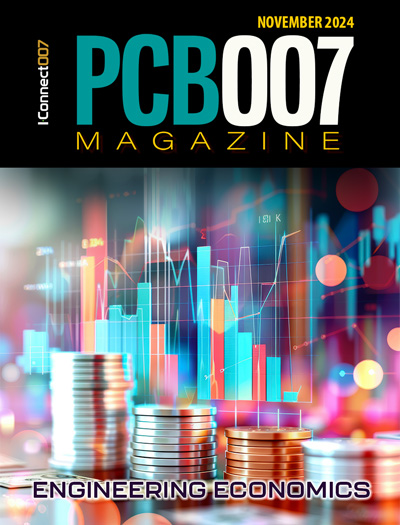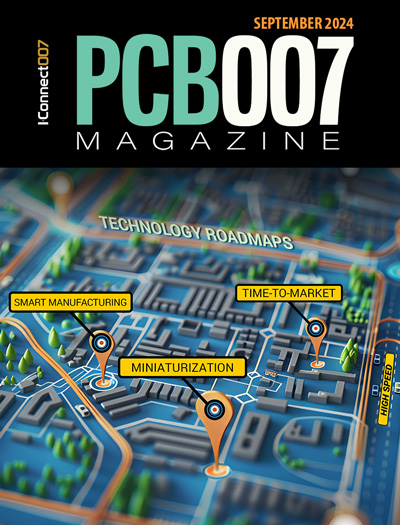-

- News
- Books
Featured Books
- pcb007 Magazine
Latest Issues
Current Issue
Engineering Economics
The real cost to manufacture a PCB encompasses everything that goes into making the product: the materials and other value-added supplies, machine and personnel costs, and most importantly, your quality. A hard look at real costs seems wholly appropriate.

Alternate Metallization Processes
Traditional electroless copper and electroless copper immersion gold have been primary PCB plating methods for decades. But alternative plating metals and processes have been introduced over the past few years as miniaturization and advanced packaging continue to develop.

Technology Roadmaps
In this issue of PCB007 Magazine, we discuss technology roadmaps and what they mean for our businesses, providing context to the all-important question: What is my company’s technology roadmap?
- Articles
- Columns
Search Console
- Links
- Media kit
||| MENU - pcb007 Magazine
DIS: Thriving With New Processes and Technologies
July 23, 2024 | Barry Matties, I-Connect007Estimated reading time: 2 minutes
What does it take to really thrive in today’s business environment? Will it require big changes, or can you make small, incremental improvements? Jesse Ziomek, global sales director and product manager at DIS, Inc., a company that designs and manufactures automation equipment, focuses on strategies for thriving in the PCB industry by emphasizing cost reduction through smart robotic solutions and addressing bottlenecks to optimize yields. He keys in on registration issues, clean manufacturing processes, and advancing manufacturing capabilities, and highlights automation and consistent manufacturing practices as crucial for industry growth.
Barry Matties: We’re talking about how to thrive in the industry, and part of that strategy is about lowering costs, an area where DIS has some new solutions. What should a bare board fabricator be thinking about if they want to thrive?
Jesse Ziomek: Thriving seems to encompass three areas within the lay-up process. First, customers are looking to solve registration issues, which ultimately increase yields; high yields equal good profits. Second, customers want to know not only how to advance their technology but the manufacturing of it what I’ll call “clean” manufacturing. What other tools and resources are available to break away from the conventional methods of hard tooling—like old-school hammer and pins and heavy plates—which carry a lot of regular maintenance costs and are labor intensive? How do we change that environment and make it a more streamlined manufacturing process that is less labor intensive?
A better work environment helps with employee retention. One can also hire a different type of employee. For example, maybe one doesn't need a super-strong employee who can pick up 45-pound-plus caul plates because we've eliminated that need with our pinless process and blocking plate technology. That’s the kind of hidden reality that comes into play.
The third area is advancing a manufacturer's technical capabilities. If you can introduce new technology that addresses one pain point, increases yields, introduces a more streamlined manufacturing process, and a safer working environment, the third jewel in the crown is advancing technology capabilities.
When customers advance their capabilities, they can enter new PCB markets, gain new customers, and strengthen existing business relationships by offering new products.
To level up, customers need new tools, resources, and education on the new processes and technologies available. That's where automation comes in. So, there is actually a fourth area, which is how we actually go about automating our processes.
To read this entire conversation, which appeared in the July 2024 issue of PCB007 Magazine, click here.
Suggested Items
China Overtakes Germany and Japan in Robot Density
11/22/2024 | IFRChina's adoption of robots continues at a rapid pace: The country has surpassed Germany and Japan in the ratio of robots to factory workers, taking third place in the world in 2023.
PCB Design Software Market Expected to Hit $9.2B by 2031
11/21/2024 | openPRThis report provides an overview of the PCB design software market, detailing key market drivers, challenges, technological advancements, regional dynamics, and future trends. With a projected compound annual growth rate (CAGR) of 13.4% from 2024 to 2031, the market is expected to grow from USD 3.9 billion in 2024 to USD 9.2 billion by 2031.
SIA Applauds CHIPS Award for Semiconductor Research Corporation’s SMART USA Institute
11/21/2024 | SIAThe Semiconductor Industry Association (SIA) released the following statement from SIA President and CEO John Neuffer commending the announcement that the U.S. Department of Commerce and the Semiconductor Research Corporation Manufacturing Consortium Corporation (SRC) are entering negotiations for the Commerce Department to provide SRC $285 million to establish and operate the CHIPS Manufacturing USA Institute for Digital Twins.
SIA Praises Finalization of CHIPS Investments for GlobalFoundries Manufacturing Projects
11/21/2024 | SIAThe Semiconductor Industry Association (SIA) released the following statement from SIA President and CEO John Neuffer applauding finalization of semiconductor manufacturing investments announced by the U.S. Department of Commerce and GlobalFoundries.
IPC Issues Clarion Call for EU to Reclaim Leadership in Electronics Manufacturing
11/21/2024 | IPCIPC released a synopsis of its recent white paper, Securing the European Union’s Electronics Ecosystem. This condensed document presents a comprehensive overview of the current challenges in Europe’s electronics manufacturing industry and shares actionable steps to help the EU achieve a stronger, more autonomous ecosystem.


